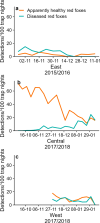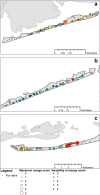Epidemiology of sarcoptic mange in a geographically constrained insular red fox population
- PMID: 38844973
- PMCID: PMC11157703
- DOI: 10.1186/s13071-024-06330-5
Epidemiology of sarcoptic mange in a geographically constrained insular red fox population
Abstract
Background: Sarcoptic mange is a skin disease caused by the contagious ectoparasite Sarcoptes scabiei, capable of suppressing and extirpating wild canid populations. Starting in 2015, we observed a multi-year epizootic of sarcoptic mange affecting a red fox (Vulpes vulpes) population on Fire Island, NY, USA. We explored the ecological factors that contributed to the spread of sarcoptic mange and characterized the epizootic in a landscape where red foxes are geographically constrained.
Methods: We tested for the presence of S. scabiei DNA in skin samples collected from deceased red foxes with lesions visibly consistent with sarcoptic mange disease. We deployed 96-100 remote trail camera stations each year to capture red fox occurrences and used generalized linear mixed-effects models to assess the affects of red fox ecology, human and other wildlife activity, and island geography on the frequency of detecting diseased red foxes. We rated the extent of visual lesions in diseased individuals and mapped the severity and variability of the sarcoptic mange disease.
Results: Skin samples that we analyzed demonstrated 99.8% similarity to S. scabiei sequences in GenBank. Our top-ranked model (weight = 0.94) showed that diseased red foxes were detected more frequently close to roadways, close to territories of other diseased red foxes, away from human shelters, and in areas with more mammal activity. There was no evidence that detection rates in humans and their dogs or distance to the nearest red fox den explained the detection rates of diseased red foxes. Although detected infrequently, we observed the most severe signs of sarcoptic mange at the periphery of residential villages. The spread of visual signs of the disease was approximately 7.3 ha/week in 2015 and 12.1 ha/week in 2017.
Conclusions: We quantified two separate outbreaks of sarcoptic mange disease that occurred > 40 km apart and were separated by a year. Sarcoptic mange revealed an unfettered spread across the red fox population. The transmission of S. scabiei mites in this system was likely driven by red fox behaviors and contact between individuals, in line with previous studies. Sarcoptic mange is likely an important contributor to red fox population dynamics within barrier island systems.
Keywords: Sarcoptes scabiei; Vulpes vulpes; Barrier island; Camera trapping; Ectoparasites; Epizootic outbreak; Red fox; Remote detection; Sarcoptic mange; Wildlife disease.
© 2024. This is a U.S. Government work and not under copyright protection in the US; foreign copyright protection may apply.
Conflict of interest statement
The authors have no competing interests to declare.
Figures





Similar articles
-
Molecular epidemiology of a fatal sarcoptic mange epidemic in endangered San Joaquin kit foxes (Vulpes macrotis mutica).Parasit Vectors. 2020 Sep 7;13(1):456. doi: 10.1186/s13071-020-04328-3. Parasit Vectors. 2020. PMID: 32894172 Free PMC article.
-
Spatiotemporal spread of sarcoptic mange in the red fox (Vulpes vulpes) in Switzerland over more than 60 years: lessons learnt from comparative analysis of multiple surveillance tools.Parasit Vectors. 2019 Nov 5;12(1):521. doi: 10.1186/s13071-019-3762-7. Parasit Vectors. 2019. PMID: 31690337 Free PMC article. Review.
-
Sarcoptic Mange of Fox Origin in Multiple Farm Animals and Scabies in Humans, Switzerland, 2018.Emerg Infect Dis. 2019 Jun;25(6):1235-1238. doi: 10.3201/eid2506.181891. Emerg Infect Dis. 2019. PMID: 31107228 Free PMC article.
-
Of microbes and mange: consistent changes in the skin microbiome of three canid species infected with Sarcoptes scabiei mites.Parasit Vectors. 2019 Oct 16;12(1):488. doi: 10.1186/s13071-019-3724-0. Parasit Vectors. 2019. PMID: 31619277 Free PMC article.
-
Sarcoptic mange in Swedish wildlife.Rev Sci Tech. 1992 Dec;11(4):1115-21. Rev Sci Tech. 1992. PMID: 1305857 Review.
References
MeSH terms
Grants and funding
LinkOut - more resources
Full Text Sources
Medical

